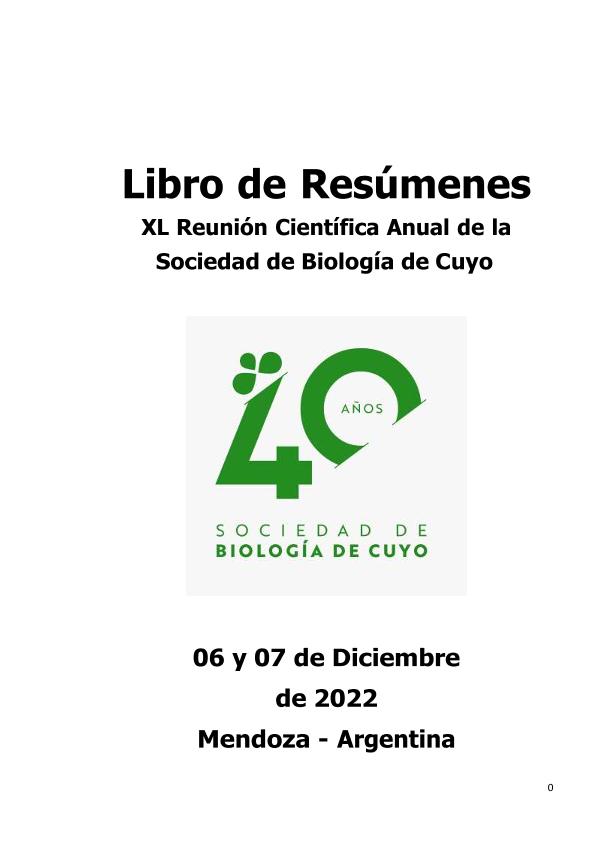Evento
Bioremediation of environments with mixed contamination: challenges and advances
Tipo del evento:
Reunión
Nombre del evento:
XL Reunión Científica Anual de la Sociedad de Biología de Cuyo
Fecha del evento:
06/12/2022
Institución Organizadora:
Sociedad de Biología de Cuyo;
Título del Libro:
Libro de resúmenes de la XL Reunión Científica Anual de la Sociedad de Biología de Cuyo
Editorial:
Sociedad de Biología de Cuyo
Idioma:
Inglés
Clasificación temática:
Resumen
In the last decades, the growing industrial activities, rapid urbanization, highest consumption rates, and non-safe human practices have greatly increased soil pollution with different contaminants, being pesticides, heavy metals, hydrocarbons, chlorophenols, and polychlorinated biphenyls the most frequently found. Therefore, it is important to device eco-friendly remediation technologies to restore the ecosystems affected by inappropriate anthropogenic action. Gentle Remediation Options such as bioaugmentation, phytoremediation, vermiremediation, and biostimulation have received considerable attention in recent years as effective risk-management strategies to reducethe transfer of contaminants to local receptors, through in-situ stabilization or extraction of pollutants. These treatments can provide a costeffective, environmentally friendly solution to soil co-pollution and are increasingly employed in place of the traditional remediation technologies. Each biological technology for soil remediation has certain limitations, and the simultaneous presence of inorganic and organic pollutants poses its own particular problems. These restrictions could be counteracted by a combination of technologies to remediate soil pollution, together with recovery of soil health. Moreover, the selection of the appropriate remediation technique/s toeffectively reduce contaminant concentrations to acceptable levels will depend on the costs, type and concentration of pollutants, edaphoclimatic characteristics, and requirements of the soil. Principles, advantages, disadvantages, and applications of the main bioremediationtechnology employed for polluted soil will be discussed. Later, case studies will be presented, to evaluate the efficiency and safety of bioremediation process of soil polluted with Cr(VI) and lindane. In this sense, it is essential to have tools of ecological relevance to assessthe biological impact of pollutants on the environment. Bioassays to evaluate the effectiveness of a bioremediation process of cocontaminated soils were applied, using five model species: four plant species (Lactuca sativa, Raphanus sativus, Lycopersicon esculentum, and Zea mays) and one animal species (Eisenia fetida). The biomarkers showed different sensitivity levels. However, two key species: L. esculentum and E. fetida, were the most sensitive to evaluate the toxic impact of Cr(VI) and lindane. On the other hand, single and combined bioremediation strategies were evaluated: phytoremediation (Brassica napus), microbial remediation (actinobacteria consortium),phytoremediation (E. fetida), an biostimulation. The combination of all strategies was the most successful treatment and would be a suitable strategy to reduce contamination and improve the health of soils co-polluted with hexavalent chromium and lindane.
Palabras clave:
Bioremediation
,
Co-contamination
,
Havy metals
,
Pesticides
Archivos asociados
Licencia
Identificadores
Colecciones
Eventos(PROIMI)
Eventos de PLANTA PILOTO DE PROC.IND.MICROBIOLOGICOS (I)
Eventos de PLANTA PILOTO DE PROC.IND.MICROBIOLOGICOS (I)
Citación
Bioremediation of environments with mixed contamination: challenges and advances; XL Reunión Científica Anual de la Sociedad de Biología de Cuyo; Mendoza; Argentina; 2022; 9-9
Compartir




